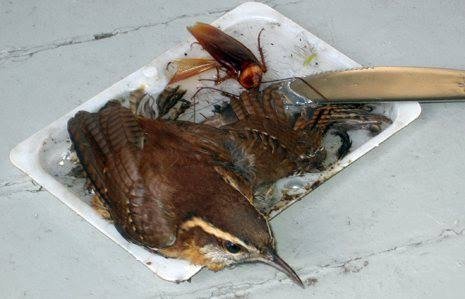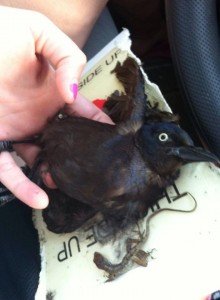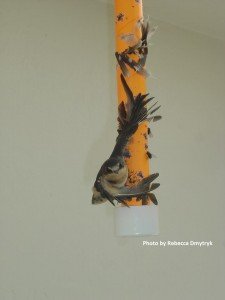
Glue traps: For compassion’s sake, please do not set, place, or hang them. Here’s why.
Sentient people recoil at the idea of leg-hold traps, those medieval–torture devices which cause so much pain and suffering before their victims eventually die, are killed, or (very occasionally) are rescued. However, many people who wouldn’t dream of setting a leg-hold trap use glue traps, which accomplish the same thing – just on a smaller scale.
The Carolina Wren pictured above was caught in a Walmart in a trap set for rodents. Like leg hold traps, glue traps are indiscriminate, with non-targeted species making up a large proportion of their catch. But be it a mouse, bird, bat, gecko, kitten … it’s a very bad way to go, and no creature should have to suffer death by torture.
“My very first rescue was a House Sparrow caught in a glue trap,” says Donna Osburn, a wildlife rehabilitator in Kentucky. “The grocery manager at a local store was using them to catch the birds that got in the building. They’d baited the trap with seed and a bit of cake! I was so far beyond furious – several people got an education they hadn’t counted on.”
The unhappy duo pictured at left, a Common Grackle and a Brown Anole, were discovered in the back of a grocery store complex in Florida. “They were found outside, so no one would take responsibility – not the grocery store, the restaurant next door, or the leasing company for the buildings,” says Amanda Margraves, a rehabber with Florida Keys Wild Bird Center. “The anole didn’t make it, but the grackle survived and was released.”
Freeing birds from glue traps is not easy. “I tell people DO NOT try to remove the bird,” says Maureen Eiger of Wildlife Care Alliance in Virginia, who gets calls from people who put glue traps in their garage, leave the garage door open, and catch birds instead of mice. “They should cover the bird’s face and put cornstarch, flour, cornmeal, or paper tissues on the rest of the trap, so he doesn’t become stuck more. Then put both the bird and the trap in a dark cardboard box so he’ll calm down, and get him to me immediately. They should outlaw sticky traps. It’s a horrid, slow way to die.”
Kathryn Dudeck, of the Chattahoochee Nature Center in Georgia, has awful stories of people who have tried to remove birds from sticky traps. “Years ago we had a call about a Ruby-throated Hummingbird caught in one,” she says. She told the couple to sprinkle oatmeal over the trap to prevent the bird from getting more adhered, and to bring it to her. “An hour later they appeared with the glue trap, and a hummer they very proudly told us they’d pulled from the trap to ‘help us out.’ We had to euthanize the poor bird immediately.”
It’s not limited to small birds, either. “We once took in a Barred Owl stuck to an 11″ x 14″ sheet,” she adds. “I didn’t even know they made them that big.”
Rehabbers have various tricks they use to remove glue from feathers, but often the birds have already lost so many feathers in their effort to free themselves that they have to be kept until they grow a new set. Rehabbers hate this. Wild birds are meant to be wild, and sometimes otherwise healthy birds simply cannot stand the stress of a long captivity.
“I only had one sticky trap bird,” says Laura Westlake, a rehabber on Long Island, New York. “A Winter Wren who came in the fall, and lost so many feathers I had to keep him until spring. He died five months later, before I could let him go.”
Fly strips, popular in stables, are bird killers too. The Barn Swallow at right was rescued by Rebecca Dmytryk of Wildlife Emergency Services in Moss Landing, California, and transferred to Native Songbird Care and Conservation in Sebastopol. “People hang the strips in their barns – where the swallows nest,” says NSCC founder Veronica Bowers. “I receive 2-3 birds each summer caught in fly strips. If people have to use them, I suggest they create a cage of chicken wire and hang the strip inside the cage.”
“Horse people love to hang flypaper, I’ve had many Barn Swallows come in stuck to them,” says Jodi Swensen, of Cape Ann Wildlife in Massachusetts. “I tell them they can also hang the flypaper inside a cheap birdcage with a half-inch or smaller bar spacing.”
“Ugh, glue traps!” says Lisa Kelly, of Teatown Lake Reservation in New York. “I’ve had to remove a few snakes and a mole … the day I was removing the very unhappy mole my cell phone rang. I said, ‘I have to call you back, I have a mole stuck to a glue trap!” and hung up. When I finally called back, they assumed I was talking about a beauty mark, and wanted to know how I’d managed to get it stuck to a glue trap. I could laugh about it because the mole was fine.”
Alternatives to mouse-catching glue traps? See Safe Rodent Control.
“Glue traps! What a coincidence,” says Mikal Deese of On A WIng and A Prayer in New Mexico. “I just spent the last hour working on a Greater Roadrunner with both feet and his tail stuck on a glue board. The homeowners were trying to catch mice. It worked, then naturally the roadrunner went after the mouse. The people were suitably horrified at what they’d done, and swore never to use the nasty things ever again.”














Amen. If you’re too squeamish to use a snap trap, you’ll never get over the misery you’ve caused with one of these things.
I agree… These are terrible. I would like to know the trick to get them out of the glue trap. They should definitely be illegal.
Agreed, Rick, but it’s important to mention snap traps do not belong outdoors. With the recent awareness about rodenticides, people are turning to snap and glue traps to solve rodent problems. Unfortunately, when placed outdoors, these devices are a significant threat to passerines and other small non-target creatures. We receive a handful of snap trap victims every year, as well as the sticky trap victims.
Pigeon shoots, rattle snake roundups, turkey drops and now glue traps. Oh boy.
Horrible!
Hello,
Erm… I know I’m gonna ask an unpopular question here but, we’re working on an RPG system and were thinking about offering birdlime as an item. (And from what I’m gathering on the net so far, we’ll definitely include how terrible it is in the description…)
Still, we were wondering here what kind of prey that kind of trap can hold to. Would it stop an eagle from flying away? Would it be dangerous to a human grabbing the glued branch? Is it comparable to every flytrap adhesive found on the market? (One of our designers here had the wrong idea on how to set such traps and removing the band glued as tapestry on the wall was an horrible experience, even after a year it was still perfectly sticky on both sides. He had to use paint thinner to clean the stuff on the wall and his hands afterwards.)
We’d also like to say that we do not plan to use the stuff ourselves to trap living animals, nor botching the work on freeing birds without calling for assistance.
Yikes this is terrible to see. I’m sure it happens by accident in most cases, but if I had done this, I’d feel absolutely terrible. Great post that will hopefully save a few birds by reaching the right readers.
It’s horrible.
That’s horrible.breaks my heart to hear about the cheep cheeps. If I ever see one, twill get Vegetable oil to free the poor cheep cheep
Vegetable oil. Although it breaks my heart that this happens to cheep cheeps
When I was a kid I found a mouse on a glue trap and tried to remove it and it tore its belly off. I was traumatized as a kid for weeks. Felt bad he was glued on it… my father quit buying them after that and I will never use again. Snap traps only. Quick and easy.
This happend to my quail I hope my quail Is resting in peace.??
Just FYI, if you use glue traps, check them daily and use vegetable oil to release the animal. It works really well. I’ve released a mouse and let it go a mile away, and several lizards. I even got some wolf spiders off who didn’t rip their legs off yet.